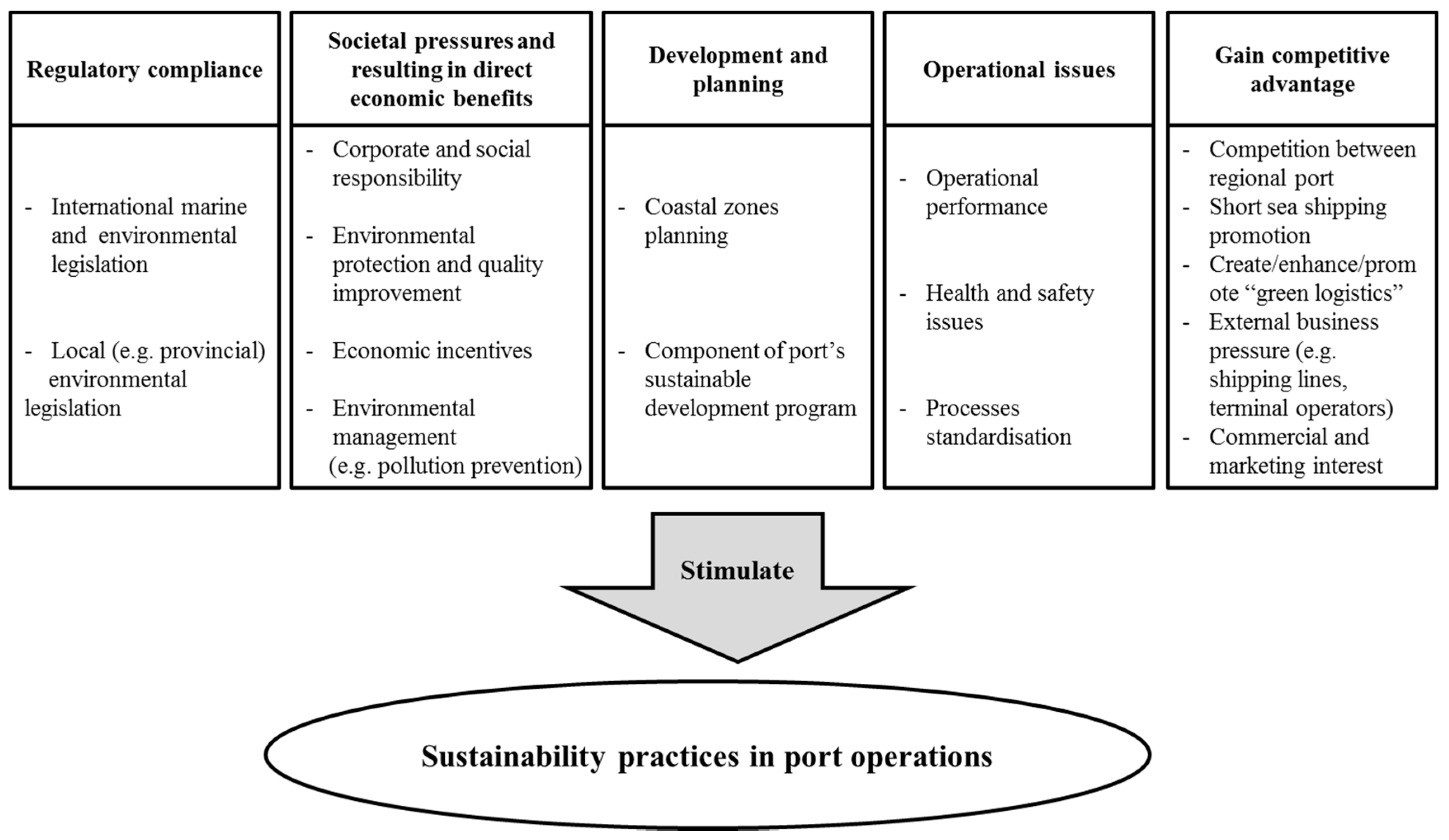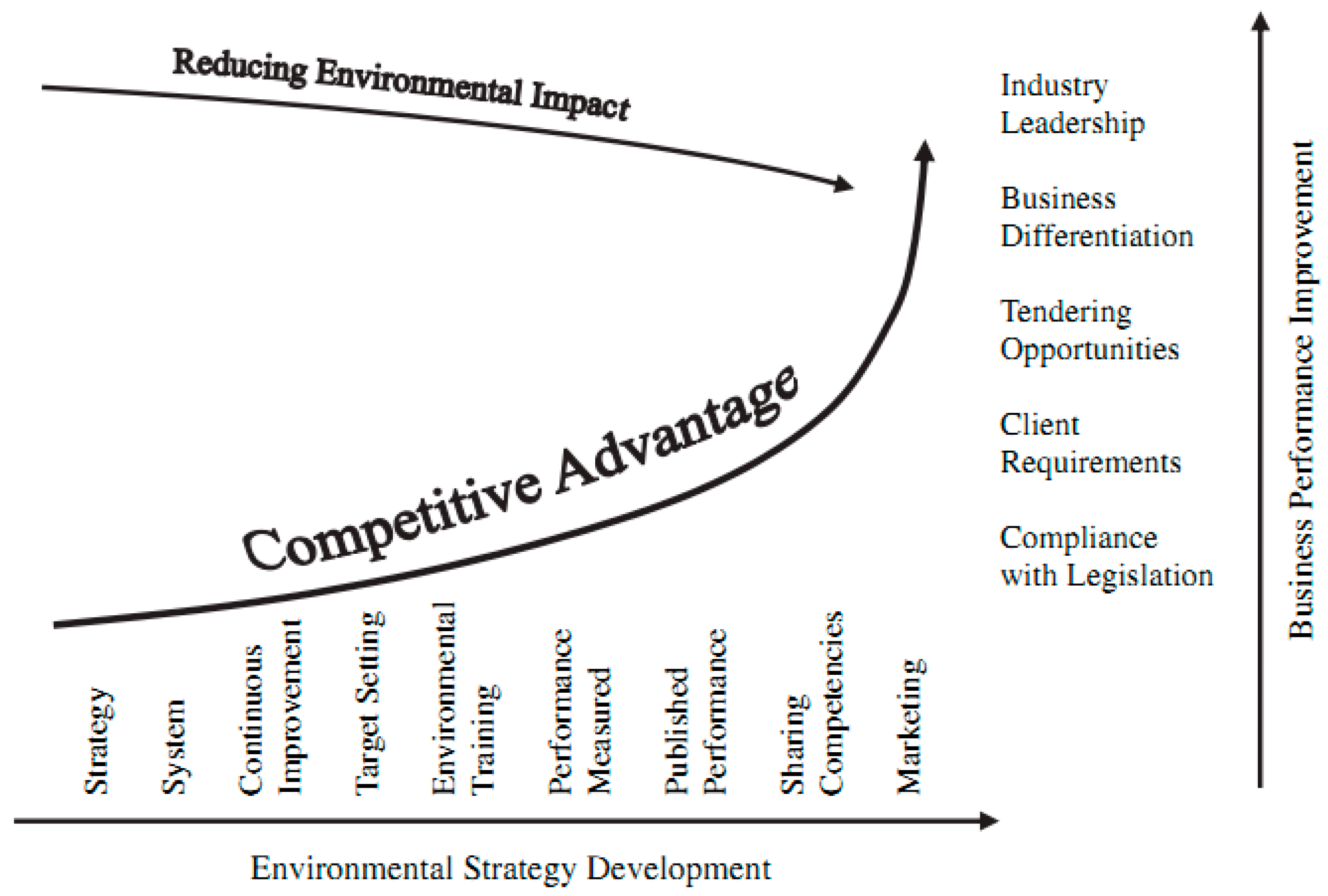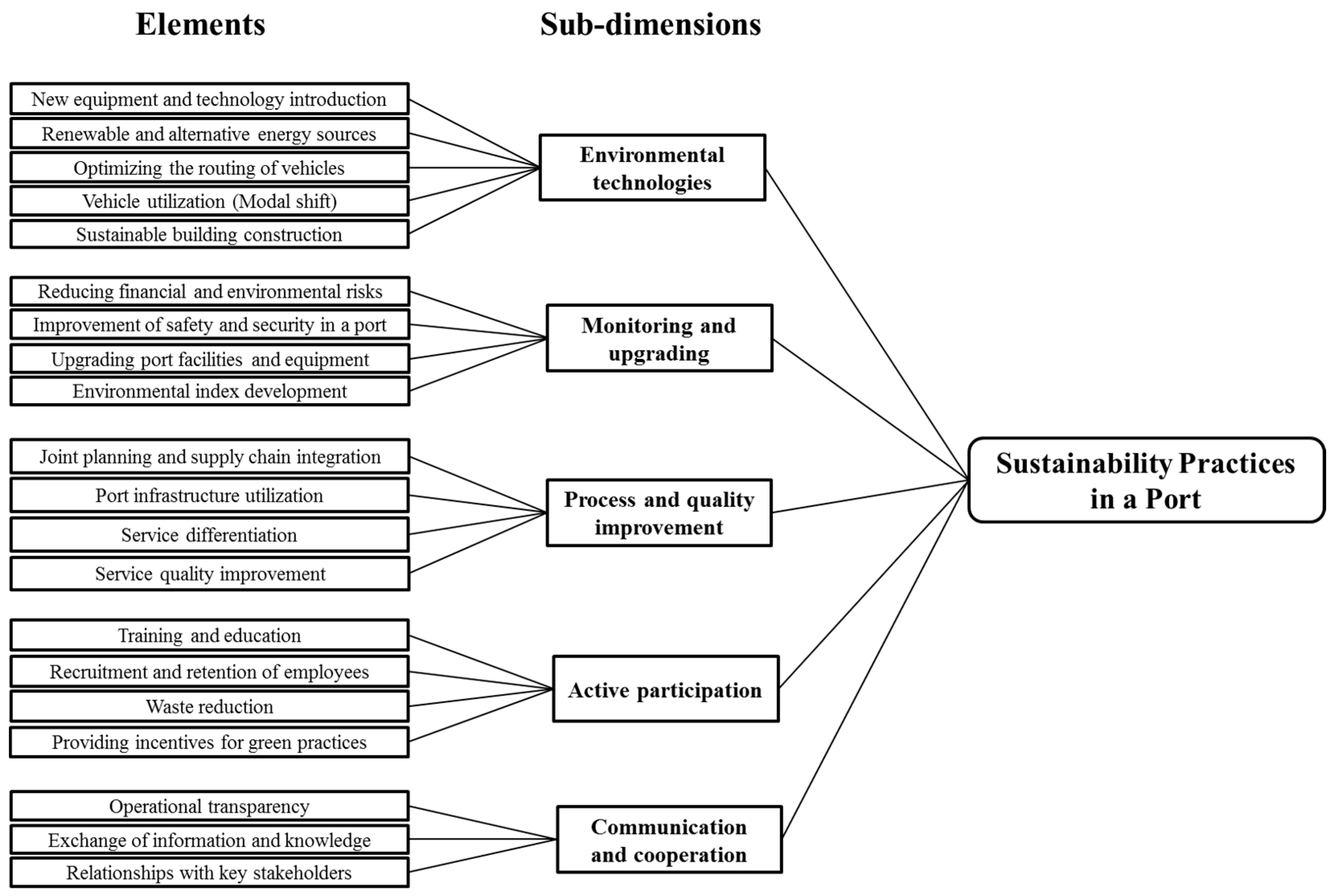Conceptual Model Development of Sustainability Practices: The Case of Port Operations for Collaboration and Governance
Abstract
:1. Introduction
- Second, ports function as an economic catalyst on revenue and employment [6,9]. As stated by [9] (p. 491), “The ratio of direct return from port operations to the indirect return from port related activities is 1:5 and the ratio of direct employment to indirect employment is around 1:9, respectively”.
- Third, with increasing environmental consciousness, environmental issues have become a central point of the strategic and operative management policies in various fields in the shipping and port industries, which aim to achieve effective protection of the environment alongside economic growth [10]. A large number of stakeholders engaged play a significant role in the governance of the port cluster, having a huge impact on port operations. The achievement of sustainable port operations and development is a difficult challenge and a complex problem to be solved, in which ports have a complex organizational and technical structure and a number of stakeholders engaged in port operations [4]. Accordingly, collaboration among the stakeholders engaged and governance for environmental performance are crucial for sustainable port operations.
- Moreover, new opportunities to achieve competitive advantage and/or to sustain a competitive position are critical issues for sustainable port development and operations in sophisticated port competition [2]. As a result, organizations and industries related to port operations have progressively begun to translate sustainability issues from a side-lined management concern into a core issue directly related to collaboration and governance for enhancing efficiency and competitiveness [1,3,10].
2. Literature Review
2.1. Port Sustainability
2.2. Sustainability Practises in Port Operations
2.2.1. Drivers of Sustainability Practise in Port Operations
2.2.2. Sustainability Practises in Port Operations
3. Method
3.1. Overview of Research Design
3.2. Data Collection
3.3. Non-Response Bias and Common Method Bias
4. Data Analysis and Results
Results of Factor Analysis
5. Discussion and Conclusions
Limitations and Suggestions for Future Research
Acknowledgments
Author Contributions
Conflicts of Interest
References
- Denktas, S.G.; Karatas, C.C. Port Sustainability and Stakeholder Management in Supply Chains: A Framework on Resource Dependence Theory. Asian J. Shipp. Logist. 2012, 28, 301–320. [Google Scholar] [CrossRef]
- Kim, S.; Chiang, B.G. Sustainability Practices to achieve Sustainability in International Port Operations. Korea Pt. Econ. Assoc. 2014, 30, 15–37. [Google Scholar]
- Kim, S. Sustainable Port Competitiveness in International Port Operations. J. Korea Port Econ. Assoc. 2015, 31, 61–74. [Google Scholar]
- Dinwoodie, J.; Tuck, S.; Knowles, H.; Benhin, J.; Sansom, M. Sustainable Development of Maritime Operations in Ports. Bus. Strategy Environ. 2012, 21, 111–126. [Google Scholar] [CrossRef]
- Low, J.M.W.; Lam, S.W.; Tang, L.C. Assessment of hub status among Asian ports from a network perspective. Transp. Res. Part A 2009, 43, 593–606. [Google Scholar] [CrossRef]
- Wang, J.J.; Cheng, M.C. From a hub port city to a global supply chain management centre: A case study of Hong Kong. J. Transp. Geogr. 2010, 18, 104–115. [Google Scholar] [CrossRef]
- Ducruet, C.; Lugo, I. Cities and transport networks in shipping and logistics research. Asian J. Shipp. Logist. 2013, 29, 149–170. [Google Scholar] [CrossRef]
- Sanchez, R.J.; Hoffmann, J.; Micco, A.; Pizzolitto, G.V.; Sgut, M.; Wilmsmeier, G. Port efficiency and international trade: Port efficiency as a determinant of maritime transport costs. Marit. Econ. Logist. 2003, 5, 199–218. [Google Scholar] [CrossRef]
- Feng, M.; Mangan, J.; Lalwani, C. Comparing port performance: Western European versus Eastern Asian ports. Int. J. Phys. Distrib. Logist. Manag. 2012, 42, 490–512. [Google Scholar] [CrossRef]
- Lun, Y.H.V. Green management practices and firm performance: A case of container terminal operations. Resour. Conserv. Recycl. 2011, 55, 559–566. [Google Scholar] [CrossRef]
- Notteboom, T.E.; Rodrigue, J.P. The future of containerization: Perspectives from maritime and inland freight distribution. GeoJournal 2008, 74, 7–22. [Google Scholar] [CrossRef]
- OECD Sustainable Development 2011. Available online: http://www.oecd.org/greengrowth/47445613.pdf (accessed on 15 April 2015).
- ESPO Green Guide 2012. Available online: http://www.espo.be/images/stories/Publications/codes_of_practice/espo_green%20guide_october%202012_final.pdf (accessed on 15 April 2015).
- Cheon, S.H.; Dwakin, E. Supply chain coordination for port sustainability. J. Transp. Res. Board 2010, 2166, 10–19. [Google Scholar] [CrossRef]
- Seuring, S.; Muller, M. From a literature review to a conceptual framework for sustainable supply chain management. J. Clean. Prod. 2008, 16, 1699–1710. [Google Scholar] [CrossRef]
- Tan, Y.; Shen, L.; Yao, H. Sustainable construction practice and contractor’s competitiveness: A preliminary study. Habitat Int. 2011, 35, 225–230. [Google Scholar] [CrossRef]
- Francisco, J.; Rodríguez, G.; del Mar Armas Cruz, Y. Relation between social-environmental responsibility and performance in hotel firms. Int. J. Hosp. Manag. 2007, 26, 824–839. [Google Scholar]
- Buyukozkan, G.; Berkol, C. Designing a sustainable supply chain using an integrated analytic network process and goal programming approach in quality function deployment. Exp. Syst. Appl. 2011, 38, 13731–13748. [Google Scholar]
- Adams, M.; Quinonez, P.; Pallis, A.A.; Wakeman, T.H. Environmental Issues in Port Competitiveness; Working Paper 7; Centre for International Trade and Transportation, Dalhousie University: Halifax, NS, Canada, 2009; Available online: http://citt.management.dal.ca/Files/Gateway/Working_Papers/Adams_7.pdf (accessed on 15 April 2015).
- Rodriguez, M.A.; Ricart, J.E.; Sanchez, P. Sustainable development and the sustainability of competitive advantage: A dynamic and sustainable view of the firm. In Sustainable Development and Competitive Advantage; Blackell Publishers Ltd.: Oxford, UK, 2002; Volume 11, pp. 135–146. [Google Scholar]
- Menguc, B.; Ozanne, L.K. Challenges of the “green imperative”: A natural resource-based approach to environmental orientation business performance leadership. J. Bus. Res. 2005, 58, 430–438. [Google Scholar] [CrossRef]
- Porter, M.E.; van der Linde, C. Green and competitive: Ending the stalemate. Harv. Bus. Rev. 1995, 73, 120–134. [Google Scholar]
- Schaltegger, S.; Wagner, M. Sustainable entrepreneurship and sustainability innovation: Categories and interactions. Bus. Strategy Environ. 2011, 20, 222–237. [Google Scholar] [CrossRef]
- Yang, C.S.; Lu, C.S.; Haider, J.J.; Marlow, P.B. The effect of green supply chain management on green performance and firm competitiveness in the context of container shipping in Taiwan. Transp. Res. Part E 2013, 55, 55–73. [Google Scholar] [CrossRef]
- Antwrp Port Sustainability Annual Report 2010. Available online: http://annualreport2010.portofantwerp.com (accessed on 15 April 2015).
- Sydney Ports Corporation Sustainability Report 2011. Available online: http://www.sydneyports.com.au/__data/assets/pdf_file/0004/17752/Sustainability_Report_2010-11_Final.pdf (accessed on 15 April 2015).
- Hakam, M.H.; Solvang, W.D. On flexibility and sustainability in container ports. In Proceedings of the IEEE Conference on Service Operations, Logistics and Informatics, Chicago, IL, USA, 22–24 July 2009; pp. 417–422. [Google Scholar]
- Hamburg Port Authority Report. Best Practice Case of Solving Problems at the Port-City Interface. Available online: http://www.iaphworldports.org/case-studies (accessed on 7 December 2017).
- Los Angeles/Long Beach Port Sustainability Report 2011. Available online: http://www.portoflosangeles.org/DOC/REPORT_Port_Sustainability_Report_2011.pdf (accessed on 15 April 2015).
- Comtois, C.; Slack, B. Sustainable development and the corporate strategies of the maritime industry. In International Workshop on Ports, Cities and Global Supply Chains; Ashgate: Aldershot, UK, 2007; pp. 233–246. [Google Scholar]
- Daily, B.F.; Huang, S.C.A. Achieving sustainability through attention to human resource factors in environmental management. Int. J. Oper. Prod. Manag. 2001, 21, 1539–1552. [Google Scholar] [CrossRef]
- Sarkisa, J.; Gonzalez-Torreb, P.; Adenso-Diaz, B. Stakeholder pressure and the adoption of environmental practices: The mediating effect of training. J. Oper. Manag. 2010, 28, 163–176. [Google Scholar] [CrossRef]
- Sharma, S. Managerial interpretation and organisational context as predictors of corporate choice of environmental strategy. Acad. Manag. Res. 2000, 43, 681–697. [Google Scholar] [CrossRef]
- Bell, S.; Morse, S. Sustainability Indicators: Measuring the Immeasurable? 2nd ed.; Earthscan: London, UK, 2008. [Google Scholar]
- Darbra, R.M.; Pittam, N.; Royston, K.A.; Darbra, J.P.; Journee, H. Survey on environmental monitoring requirements of European ports. J. Environ. Manag. 2009, 90, 1396–1403. [Google Scholar] [CrossRef] [PubMed] [Green Version]
- Pallis, A.A.; Vaggelas, G.K. Port competitiveness and the EU ‘port services’ directive: The case of Greek ports. Marit. Econ. Logist. 2005, 7, 116–140. [Google Scholar] [CrossRef]
- Winkelmans, W.; Notteboom, T. Port master planning: Balancing stakeholders’ interests. In The Reality and Dilemmas of Globalization.—Gdánsk; Dobrowolski, K., Zurek, J., Eds.; The Foundation of the Development of Gdansk University: Gdansk, Poland, 2007; pp. 395–408. [Google Scholar]
- Podsakoff, P.M.; MacKenzie, S.B.; Lee, J.Y.; Podsakoff, N.P. Common method biases in behavioral research: A critical review of the literature and recommended remedies. J. Appl. Psychol. 2003, 88, 879–903. [Google Scholar] [CrossRef] [PubMed]



| Practices | Description | Details |
|---|---|---|
| Reducing financial and environmental risks in ports |
|
|
| Upgrading port facilities and equipment to cut operation costs |
|
|
| Sustainable building construction in a port/hinterland |
|
|
| Enhancing long-term viability of operations |
|
|
| Safety and security in a port |
|
|
| Resource efficiency |
|
|
| Eco-friendly and socially responsible image |
|
|
| Improving relationships with key stakeholders |
|
|
| Port infrastructure utilization |
|
|
| Optimizing the routing of vehicles |
|
|
| Vehicle utilization (Modal shift) |
|
|
| Employee productivity |
|
|
| Recruitment and retention of employees |
|
|
| The hinterland social and working environment |
|
|
| Expansion of the coastal region facilities |
|
|
| Providing incentives for green practices |
|
|
| Code * | Elements | References |
|---|---|---|
| SP 1 | New equipment and technology introduction | [2,4,20,32] |
| SP 2 | Renewable and alternative energy sources | [2,30,31,33] |
| SP 3 | Sustainable building construction | [33,34] |
| SP 4 | Optimizing the routing of vehicles | [1,2,3,14,16] |
| SP 5 | Vehicle utilization (Modal shift) | [2,4,24] |
| SP 6 | Reducing financial and environmental risks | [2,4,31,34] |
| SP 7 | Improvement of safety and security in a port | [4,17,35] |
| SP 8 | Upgrading port facilities and equipment | [1,2,3,4] |
| SP 9 | Environmental index development | [33,34] |
| SP 10 | Eco-friendly and socially responsible image | [20,33,34] |
| SP 11 | Port infrastructure utilization | [1,2,3,4,14] |
| SP 12 | Efficiency of the use of the port area | [2,7,33,34] |
| SP 13 | Service differentiation | [2,3,35] |
| SP 14 | Service quality improvement | [2,17,35] |
| SP 15 | Joint planning and supply chain integration | [1,14,16,31] |
| SP 16 | Operational transparency | [31,33] |
| SP 17 | Exchange of information and knowledge | [1,2,3,4,16] |
| SP 18 | Close relationships with key stakeholders | [2,3,4,14,16] |
| SP 19 | Recruitment and retention of employees | [14,29,36] |
| SP 20 | Good working environment | [1,2,3,4,5,14,17] |
| SP 21 | Waste reduction | [2,30,31,33] |
| SP 22 | Training and education | [2,4,29] |
| SP 23 | Providing incentives for green practices | [2,3,14,17] |
| Variable | Frequency | Percentage (%) |
|---|---|---|
| Organization Type | ||
| Port Authority | 36 | 17.8 |
| Terminal Operator | 48 | 23.6 |
| Shipping line | 23 | 11.3 |
| Inland Shipper | 27 | 13.3 |
| Forwarder/Cargo Owner | 26 | 12.8 |
| National/Local Government | 26 | 12.8 |
| Local Community/Researcher | 17 | 8.4 |
| Firm’s Age | ||
| Less than 5 years | 9 | 4.4 |
| 5–10 | 46 | 22.7 |
| 10–15 | 29 | 14.3 |
| 15–20 | 22 | 10.8 |
| Over 20 years | 97 | 47.8 |
| Number of Employees | ||
| Less than 50 | 46 | 22.6 |
| 50–100 | 28 | 13.8 |
| 100–150 | 13 | 6.4 |
| 150–200 | 17 | 8.4 |
| 200–250 | 16 | 7.9 |
| 250–300 | 33 | 16.3 |
| More than 300 | 50 | 24.6 |
| Working Experience | ||
| Less than 5 Years | 16 | 7.8 |
| 5–10 | 18 | 8.9 |
| 10–15 | 55 | 27.1 |
| 15–20 | 69 | 33.9 |
| Over 20 | 45 | 22.3 |
| Job Position | ||
| Senior | 106 | 52.3 |
| Middle | 62 | 30.5 |
| Junior | 35 | 17.2 |
| Factor * | Mean | Std. Deviation | t-Value | Sig. | ||
|---|---|---|---|---|---|---|
| Early (n = 50) | Late (n = 50) | Early | Late | |||
| ET | 3.6960 | 3.7200 | 0.60507 | 0.52060 | −0.213 | 0.832 |
| MU | 3.3050 | 3.1900 | 0.58312 | 0.49115 | 1.067 | 0.289 |
| PQI | 3.7920 | 3.6160 | 0.64265 | 0.64376 | 1.368 | 0.174 |
| AT | 3.1900 | 3.3450 | 0.67302 | 0.69783 | −1.130 | 0.261 |
| CC | 3.3120 | 3.1680 | 0.93211 | 0.68852 | 0.897 | 0.382 |
| Items * | Factor Analysis | |||||
|---|---|---|---|---|---|---|
| ET | PQI | MU | CC | AP | Cronbach’s α | |
| SP 1 | 0.821 | |||||
| SP 2 | 0.816 | |||||
| SP 4 | 0.814 | 0.854 | ||||
| SP 5 | 0.721 | |||||
| SP 3 | 0.695 | |||||
| SP 6 | 0.772 | |||||
| SP 7 | 0.754 | 0.852 | ||||
| SP 8 | 0.754 | |||||
| SP 9 | 0.730 | |||||
| SP 15 | 0.780 | |||||
| SP 11 | 0.774 | 0.823 | ||||
| SP 13 | 0.739 | |||||
| SP 14 | 0.691 | |||||
| SP 22 | 0.798 | |||||
| SP 19 | 0.778 | 0.785 | ||||
| SP 21 | 0.754 | |||||
| SP 23 | 0.682 | |||||
| SP 16 | 0.807 | |||||
| SP 17 | 0.782 | 0.818 | ||||
| SP 18 | 0.757 | |||||
| Eigen-value | 6.581 | 2.400 | 1.991 | 1.392 | 1.058 | |
| % of Variance | 32.907 | 12.000 | 9.957 | 6.962 | 5.292 | Total: 67.118 |
© 2017 by the authors. Licensee MDPI, Basel, Switzerland. This article is an open access article distributed under the terms and conditions of the Creative Commons Attribution (CC BY) license (http://creativecommons.org/licenses/by/4.0/).
Share and Cite
Kang, D.; Kim, S. Conceptual Model Development of Sustainability Practices: The Case of Port Operations for Collaboration and Governance. Sustainability 2017, 9, 2333. https://doi.org/10.3390/su9122333
Kang D, Kim S. Conceptual Model Development of Sustainability Practices: The Case of Port Operations for Collaboration and Governance. Sustainability. 2017; 9(12):2333. https://doi.org/10.3390/su9122333
Chicago/Turabian StyleKang, Dalwon, and Sihyun Kim. 2017. "Conceptual Model Development of Sustainability Practices: The Case of Port Operations for Collaboration and Governance" Sustainability 9, no. 12: 2333. https://doi.org/10.3390/su9122333
APA StyleKang, D., & Kim, S. (2017). Conceptual Model Development of Sustainability Practices: The Case of Port Operations for Collaboration and Governance. Sustainability, 9(12), 2333. https://doi.org/10.3390/su9122333





